1/ Fulstow Suicide, August 1901
Francis Mason the 27-year-old son of a Grimsby solicitor, had been seeing a young lady in the town but now the two had parted company. He threatened to commit suicide a couple of months previously but it was laughed off as idle talk. He left a suicide note addressed to his father and, on the tombstone of a suicide in the churchyard, he wrote the following:- “God Forgive me this deed”. It was judged to be a suicide whilst of unsound mind.(What… a suicide in the churchyard?)
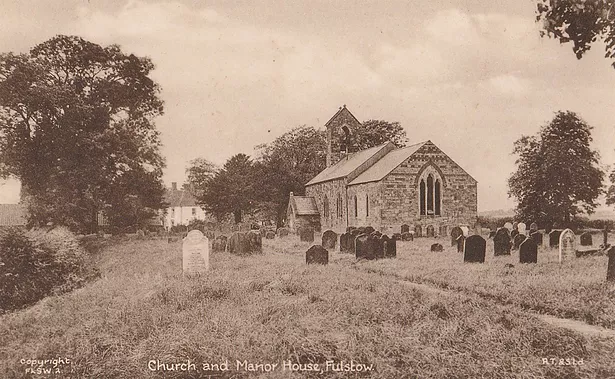
2/ Fulstow Gun Fatality, March 1887
William Sutton a labourer for Mr Richardson aged thirty-two, met with his death in a million-to-one accident when a gun fell over and fired its contents straight into his body. Sutton had gone out with a man named Marshall and returned at eight o’clock to Sutton’s house. When just outside the two were saying goodbye, when Sutton took the barrel of the gun out his pocket, which had been in two pieces when it fell to the ground and exploded. The contents went right in his side killing him instantly. It must have fallen on the nipple due to the stone-chip that was found on it. He left a widow and one child.
3/ Fulstow Child Death, October 1888
An inquest was held at the Cross Keys Inn touching the death of William Arthur Johnson, the illegitimate child of Hannah Johnson, a widow. The baby was ten weeks old when it expired with Hannah having four other children to provide for. She was in receipt of parish relief for herself and the kids at the time he was born. The Guardians stopped the outdoor relief and gave her order for the house, which she flatly refused. (Equivalent would be today, that they stopped her housing benefit saying she’d have to move to a workhouse). The autopsy revealed that the little fellow had died from lack of proper nourishment but no blame was attached to the mother. The Guardians were to blame for their actions said the jury afterwards.
4/ Fulstow Suicide, November 1888
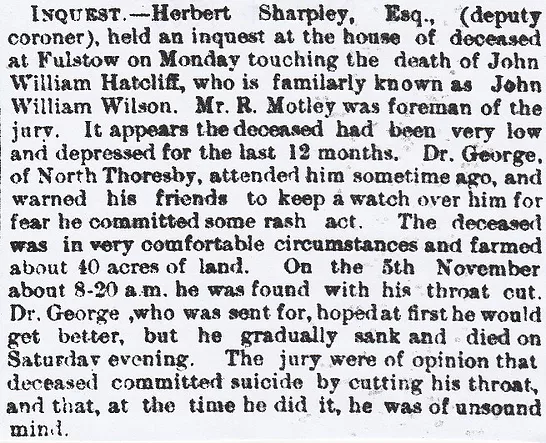
5/ Donna Nook, April 1876 (Body Washed Ashore)
More famous these days for a grey seal colony that is here most of the winter/ spring and also well-known for its Royal Air Force bombing range. Not while the seals are there! In the Victorian era, it was a hot-spot for shipwrecks and washed up bodies, or flotsam and jetsam. This body was of a Welshman, Hugh Roberts aged twenty-six, the steward of a Liverpool ship of 12,000 tons, the “Victory”, which was washed ashore on the 14th April and was wrecked. It was on it’s way from Newcastle to San Francisco laden with coal and with a crew of twenty-eight who were all lost. The captain was found floating off Spurn Point and taken to Grimsby but Hugh was washed up on the beach at Donna Nook.
6/ Donna Nook Shipwreck, May 1886 (Four Deaths)
The “Mermaid” was bound for Hartlepool when it came ashore at Donna Nook. The coastguard, Edward Long, and a farmer named Brooks from Somercotes saw four men leaving the ship in a lifeboat and so rushed to rescue the rest of the crew who were still stranded. They managed to get most of the men, when the captain, the mate, and another got into the vessel. A large wave engulfed the life-boat and they were thrown into the choppy waters of the German Ocean. One of the men got back to the vessel and Long grabbed an oar to keep himself afloat, but Brooks, the master and mate and the divisional carpenter were drowned. Deceased are Brooks, a coastguard named Richards, and the master and mate of the “Mermaid”. The carpenter left a widow and several children.
7/ Donna Nook Drowning, November 1884
John Phillips was drowned in the mouth of the Humber, whilst endeavouring to give and render assistance the smack “Economy” which at the time was in distress, and was signalling for relief from off the shore. John Phillips was interred at North Somercotes Cemetery and was witnessed by a large crowd. The coffin was conveyed on the lifeboat carriage belonging to the coastguard and covered in a Union Jack. Coastguards marched with arms reversed with the men included, those from between Tetney Haven and Sutton inclusive.
8/ Donna Nook, July 1890 (Another body!)
9/ Covenham, January 1865 (Childs Body Found)
The body of a child which had apparently been born alive was found in a privvy in this village on Monday last. As far as could be judged from the decomposition of the body it had been secreted at least a month. An inquest was opened Thomas Sharpley, the coroner for the district, but in consequence of the absence of necessary medical evidence, it was adjourned. Suspicion rests on a girl living in the village of being the mother but had no particulars at the time. (Was it “the girl”?)
10/ Covenham, near Firebeacon (Lane?), April 1866
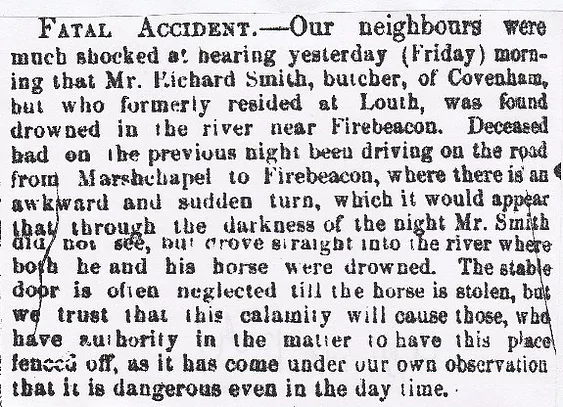
11/ Covenham Fatality, May 1865
A labourer named Clark in the employ of Mr Young of Covenham, met with his death in the following shocking manner on Friday the 28th April. He had been to Louth with the waggon and horses and was returning with a load of lime and had nearly reached home, when he fell and the wheels passed over his head, causing instantaneous death. He was a married man and leaves a widow and five children.
12/ Covenham Fatal Accident, April 1884
A man named Kirk who worked for Mr Drayton, a farmer, were both taking a borrowed machine home at about 5-30 when the horse suddenly got the better of Kirk and he threw the reins down. His master gathered them and Kirk was thrown to the ground, and when the horses eventually stopped Kirk was tended to. He was taken home but died early the next morning. Mr Drayton said they were on the road leading to Fen Bridge when the accident occurred and he stopped about 100 yards down the road when he got control of the animals again. Drayton said two men were holding up his head, but he was partly unconscious. The doctor said he received injuries to the brain as he suffered from rigid limbs and dilated pupils and noisy respiration.
13/ Covenham Murder, April 1859


14/ Binbrook Murder, April 1959
Twelve-year-old Janice Ann Holmes of Hall Farm Cottages was found dead in some woodland about half a mile from where she lived. Janice had walked a friend of her’s home at about 8-30 p.m. but was gone for ages. The mother called the police and they began a systematic search of Binbrook and the area surrounding it. After several hours her lifeless corpse was discovered in the woods. A local farmhand was later charged with her murder.
15/ Binbrook, March 1869 (Burned to Death)
Jane Swaby aged sixteen years, was burned to death on the 22nd February. She was described in the paper as being both idiotic and a cripple and she had been left alone in the house while Mum went to the neighbours. Jane tried to get something off the mantel-piece when her clothes ignited in the fire and she was so dreadfully burned that she succumbed to her injuries the next day. The verdict was one of “Accidental Death”.
16/ Binbrook, November 1864 (Crushed in a Mill)
A shocking and fatal accident occurred on the 12th November in Binbrook, to a boy named Thomas Griffiths aged 10. The boy had entered the mill of Mr W.Short on some errand when some moments later he was found by him amongst the machinery, crushed to pieces. An inquest was held on the mangled remains and the verdict was “the said Thomas Griffiths died from injuries received from the machinery of a windmill”.
17/ Binbrook, December 1900 (The building with the cutaway corner, off Mount Pleasant, the houses nearby were known as “Ranter’s Row”)
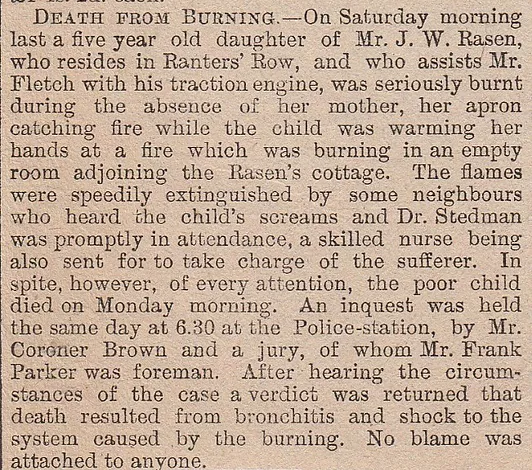
18/ Binbrook (Bewitched Farm), December 1904-January 1905
Walk Farm, owned by Mr W.Drakes, was known in the years of 1904-1905 as the Bewitched Farm due to the poltergeist activity and strange happenings at the place. Some of them are so far-fetched that you might as well laugh out loud than believe them. A rabbit hanging on a hook, got down ran around a bit then crawled back up and hung itself where it was. Plant pots tilting on their sides etc. A servant’s clothing spontaneously combusted even though there was no fire lit in the room, and she received severe burns to the skin. Certain animals, mainly poultry, had their throats torn out by this unseen spirit, an empty wheelbarrow going uphill, and horses unable to pull an empty waggon. It was apparently the ghost of a girl who had been murdered at the farm. I believe it’s still there, correct me if I’m wrong.
Walk Farm, Binbrook.
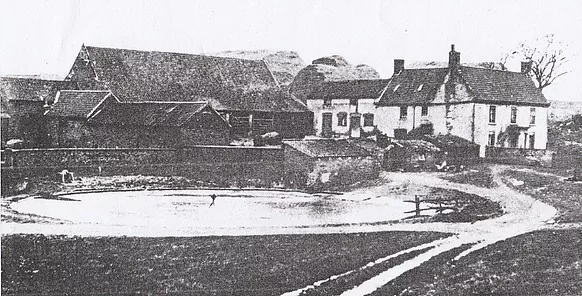
19/ Binbrook Poisoning, March 1881

20/ Claxby Poisoning, March 1797
Fortunately for Elizabeth Brocklesby burning at the stake for the crime of murder was abolished in 1790, so the housewife from Claxby who poisoned her husband William Brocklesby was hanged at Lincoln for her terrible crime. As was usual with the bodies of murderer’s, they were handed to surgeons who carried out medical experiments and dissected for tutorial purposes.
21/ Claxby, January 1897 (Landlord Accidentally Shot)
Mr John Hill was the landlord of the Pelham Arms public-house in Claxby. He went out shooting on the moor and put down his gun so that he could climb across a ditch. He slipped and fell awkwardly, and when the search party found him there he was already extinct, from a dislocated neck. The faithful hound that he owned stayed by his side until the party arrived.
22/ Alvingham Child Murder, August 1874
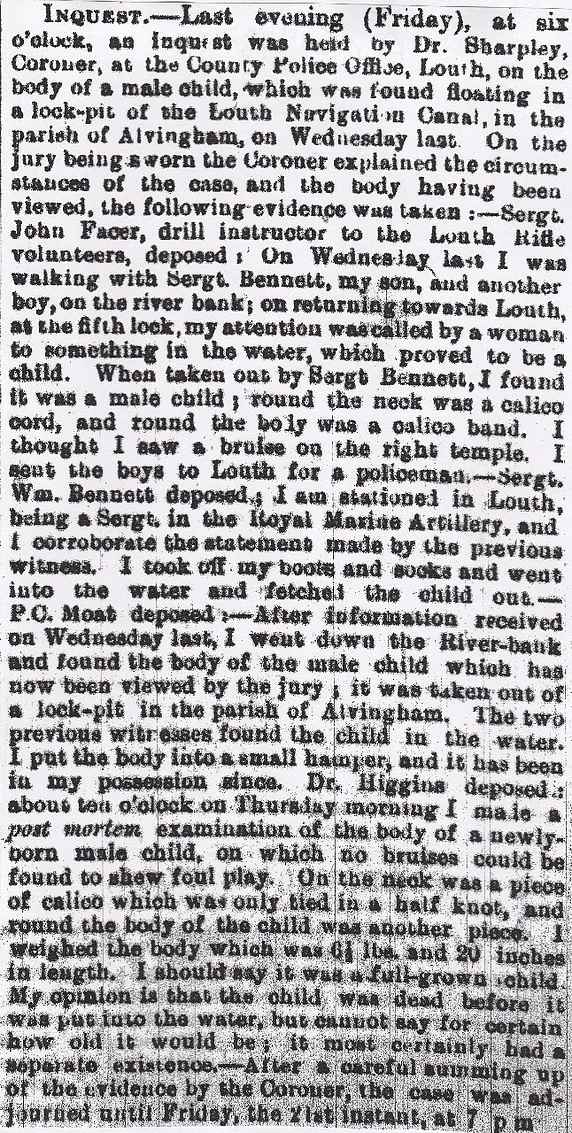
Alvingham Child Murder, August 22nd, 1874
The child was found floating in Salter’s Fen lock (which is next to Keddington Sewage Works), by a licensed hawker named Maria Fearburn.
August 29th, 1874
18-year-old Elizabeth Phillips was charged with the wilful murder of her male child on or about the 8th August. She worked at Tealby for a farmer named Bland Herring, whose wife spotted she was pregnant when she first got the job there. Mr Herring’s wife went away between the 27th July and the 4th August and was told the girl had had a baby boy. She then left on the 8th August and returned on the 19th August minus the child, saying the sister to the father of the child had taken it to Hull with her.
March 20th, 1875
On Saturday, Elizabeth Phillip aged eighteen, a domestic servant, was arraigned for the murder of her illegitimate child by throwing him into the Louth Navigation Canal in the parish of Alvingham on the 8th of August,1874. Mr Laurence ably defended the prisoner, and the jury returned a verdict of “Not Guilty”, and she was freed.
23/ Louth Navigation Canal Suicide, Alvingham, July 1871
George William Brogden was found in the Louth Navigation Canal near Alvingham. His hat and stick were left on the bank, which seems to suggest a premeditated suicide. The corpse was found by Alfred Ticklepenny and a workman named Markham when they fished him out with a rake. They found a pocket-book on him as well as a pencil, ticket for Louth Athletics Club and some loose change. On the paper was written, “God bless you, father and mother, and forgive me, your son”. Deceased was only seventeen years old and everybody spoke highly of him saying he was an affectionate, hard-working and as pleasant a teenager as anyone could meet. Why the suicide at Salter’s Fen Lock?
24/ Louth Canal Fatality, October 1863
A young man named Hall aged nineteen, while engaged on board a vessel in the canal leading from Louth to Tetney Lock near Alvingham, caught his toe against a projection on the deck and fell overboard. Before they could get him out of the water, life was extinct. A verdict of “Accidental Death” was returned.
25/ Alvingham Child Poisoning, (Elizabeth Vamplew) July 1862
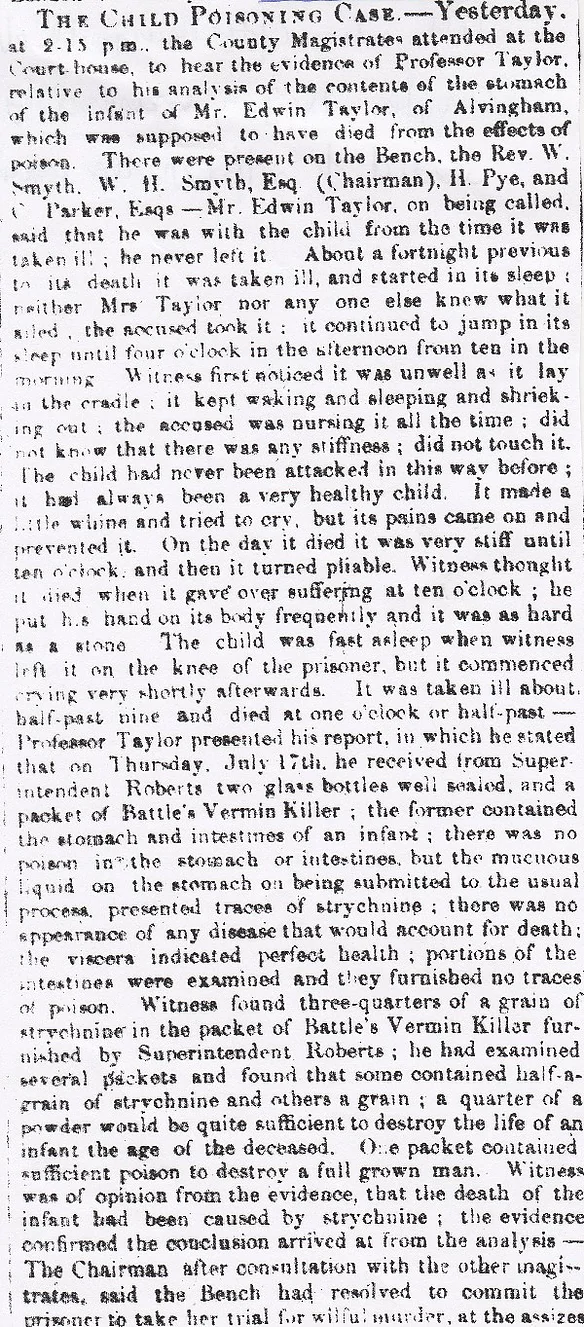
to be held at Lincoln on Monday next- At the Jolly Sailor Inn last night, the adjourned inquest was held, when, after hearing the evidence of Professor Taylor, the jury unanimously returned a verdict of wilful murder against Elizabeth Vamplew.
August 2nd, 1862
13-year-old Elizabeth Vamplew pleaded not guilty to the charge of wilful murder of Kate Mary Taylor aged ten weeks, by administering “Battle’s Vermin Killer” to it. Vamplew had been given the day off to go to Grimoldby school feast and had been in the mother’s care all that day. When she was given to the girl at around eight p.m. and with the family retiring to bed, the baby began to cry. The child became increasingly poorly and vomiting. Vamplew admitted to giving it poison because “she was tired of lugging it about”. Found guilty of manslaughter.
26/ East Halton, May 1868 (Lightning Death)
At East Halton, a populous village near Thornton Abbey, a young man named Elm who was about twenty years of age and employed by Mr Slight at the village windmill, was engaged in altering the gear of the brake which is connected with the exterior of the mill,when he was struck by lightning and instantly killed.
27/ Brocklesby, July 1915 (Motorbike Accident)
The secretary of the Grimsby and Cleethorpes Amateur Swimming Association, Harry Hill, died at the Red Cross Hospital at Brocklesby, due to injuries he sustained while riding his motorbike between Kirmington and Limber and due to a side-slip. Mr Hill was only twenty-three years of age and was soon to have been married.
28/ The Cottams near Brocklesby, May 1849 (Murder)
Catherine Farrow, the wife of a cottager living on the Earl of Yarborough’s Brocklesby estate, was on her way to the next village, Keelby, and going through a field as a short-cut and must have met her murderer there. Her corpse was found on a path with her head smashed in, probably with a heavy instrument like a hammer or a stone. The police arrested a bloke called Charles Overton on suspicion of murder.
29/ Brocklesby Railway Station Death, November 1862
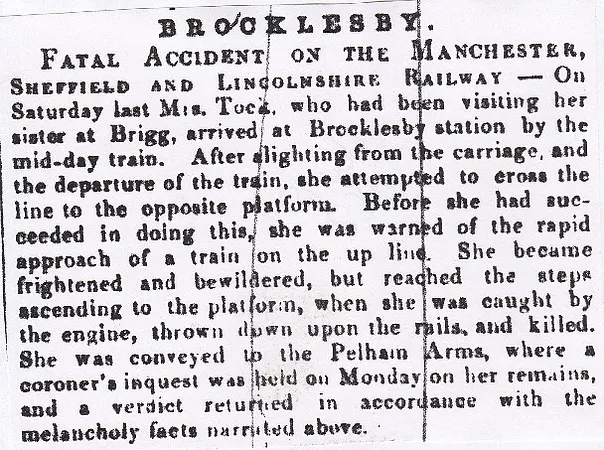
30/ Brocklesby/Barnetby, February 1879 (Four Killed in Bridge Collapse)
While workmen were engaged in demolishing Chalk Hill Bridge which crosses the railway from Melton Ross to Kirmington, an accident occurred which caused four men to die. It was said to be in danger of collapsing, such was the poor state it was in. They placed seventeen shots of blasting powder in various places but this had no effect on the structure. They decided to tear it down by gradually dismantling it, but when they had got a small portion of the brickwork out the entire bridge collapsed killing four and injuring over a dozen others. The names of those killed are -Edward Ambler, ballast guard and foreman of the gang, from Brigg; Robert Johnson of Brigg; Ellis Hornsby aged twenty-six, of Brigg; Thomas Robinson of Croxton.
31/ Barnetby Junction Fatality, September 1873
Robert Marris aged twenty-three, who worked for the Manchester, Sheffield,and Lincolnshire Railway Company as a fireman, was killed at Barnetby Junction. Marris was sprinkling sand on the rails before the engine and somehow overbalanced and fell on the line, with the engine running over him and literally slicing him in two.
32/ Barnetby-le-Wold Triple Murder, August 1847
Mary Anne Milner was sentenced to death for the wilful murder of her mother-in-law, Mary Milner, Hannah Jickels who was her sister-in-law, and Ellen Jickels who was her niece. The callous cow murdered these women for the few quid she would have got from the burial clubs when the women met their maker. Milner made some sago pudding for the mother-in-law Mary Milner, and put some arsenic in it. The old woman died soon after and she collected the cash. The wheels were now set in motion and her next victims, Hannah and Ellen Jickels, would be along the same lines. This time Milner made them pancakes and laced them with arsenic as well. Before the day had ended they were both lying in the morgue awaiting an autopsy, and Milner could again collect the burial club money. People began to gossip and police got involved, and Milner broke down and confessed to all three killings. She later committed suicide in her cell with thousands waiting outside to see her hang.
33/ Barnetby Railway Disaster, October 1898 (Eight Killed)
An awful railway disaster occurred at Wrawby Junction near Barnetby Station, with the death toll of eight and around twenty more people seriously injured. The bodies were taken after the crash to the Railway Hotel in Barnetby. It had left Cleethorpes at 4-50 p.m., and had gone through the station at Barnetby, and got to the junction at about 5-20 p.m. when it collided with a heavy goods train that was being shunted, and it being an express train it travelling at a maximum speed of about 50 m.p.h. The dead were;- Emma Verity Wilson aged thirty-four, from Ossett; John Thomas Brown aged twenty-four, from Dewsbury; Amaziah Butters aged forty-four, fish buyer from Cleethorpes; Edwin Iredale from Elland (Leeds); Martha Bennett aged fifty-four, from Leeds; Eliza Lane from Brereton Ave, Cleethorpes; plus a couple of unidentified others.
34/ Brinkhill Death, (between Louth/Spilsby) March 1895

35/ Appleby near Scunthorpe, May 1882 (Fatal Accident?)
An inquest was held at the Schoolroom at Appleby, on the body of Thomas Cavill Nelson, who was shot accidentally the previous day. Deceased’s groom, John Eyre, said that he left at 10-30 that morning, with a gun in hand and soon afterwards he heard a groan. He ran to the garden and found Nelson on the ground with the muzzle end of the gun near his feet. He mumbled to him “that he was leaning over and the gun just went off”. Within the hour he was dead. The brother of the deceased, John Nelson, said that his brother normally carried a gun about to shoot birds on his strawberries and rats near the poultry.
36/ Bonby Suicide? near Brigg, July 1884
Sixty-two-year-old George Curtis was an agricultural labourer from Bonby in North Lincolnshire. The old fella had been depressed of late. At six a.m. on Saturday morning he went for a walk along the banks of the River Ancholme and did this for about five hours. At lunch-time, the same day he was discovered bolt upright in the river near his home village, with his jacket left folded on the bank. The verdict was “Found Drowned”, as they couldn’t ascertain whether he had deliberately or accidentally entered the Ancholme.
36/ Bonby Murder, October 1850
An affray took place in Bonby between seventy-two-year-old Robert Meggitt and Robert Sinderson, who lived near the old man. Late one evening the vile-tempered old coot woke his son and grandchildren up from the noise of the harsh beating he was dishing out to Mrs Meggitt. They shouted for help and Sinderson turned up and intervened in the husband/wife scuffle. He pinned Meggitt to the bed and told Mrs Meggitt to get out of the house. The old man wriggled free and grasped his pen-knife and stabbed Sinderson. He managed to stagger out and get back to his house, with his bowels protruding and losing blood at a fair rate. He clung to life for a couple of days but died from the horrific injuries he got in the attack. (What sentence did Meggitt get?)
37/ Burwell, (Concealment of Birth) December 5th, 1868
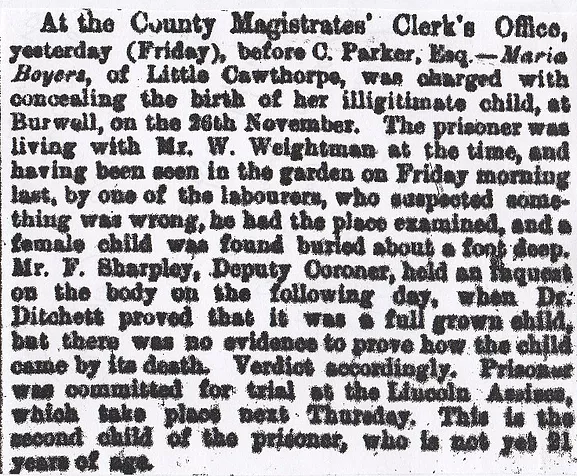
December 19th, 1868
Maria Boyers aged twenty, pleaded guilty of concealing the birth of her child at Burwell on November 27th, 1868. Sentenced to two months imprisonment with hard labour.
38/ Burwell Ice Fatality, February 1860
On the 10th February at Burwell, a group of people had decided to go skating on the frozen over pits, with John Dickinson (who worked for J.Heanley of Ruckland) going that little bit further. The ice cracked and John fell in and he was under the ice for three hours, before his lifeless corpse could be extricated.
39/ Stag’s Head Inn? Suicide, Burwell, January 1867
On Wednesday last, Mr Robinson, a farmer and innkeeper of Burwell near Louth, put an end to his existence by hanging himself in the brew-house. The deceased was seventy-five years of age and had been rather unsettled in his mind for some time, and it is supposed that he was suffering from an attack of temporary derangement when he committed the rash act. An inquest was held on the body by T.Sharpley, Esq, coroner, on Thursday, and a verdict to that effect was returned. (Was brew house at Stag’s Head pub?)
40/ Stag’s Head Inn, Burwell near Louth, January 1880 (Man Found Dead in Mash Tub)
Considering how big Burwell is, it had a fair bit of tragedy in the two decades between 1860 and 1880. This one is a singular accident that happened to the brewer at the Stag’s Head Inn (Last time I drove past this, it was closed and up for sale). George Ward was a 44-year-old brewer and butcher from No 34, James Street, Louth, who was working for Mrs Odling at the Stag’s Head. He was there all night and the following day in brewing and was helped by a man named Atkinson. He was pottering about all day, the odd cup of tea, nothing alcoholic to drink, when Atkinson returned to see if everything was going OK. On entering the brew-house he observed that he was in a peculiar position. While standing on the floor his head and shoulders were partly submerged in the tub of new beer. He raised the alarm but the chap was quite dead. It was thought to be the carbonic acid gas that had killed him, and it arose from the mash-tub when brewing.During fermentation at certain stages the liquor gives off gases of various kinds, and these could produce fatal effects. His wife, Charlotte Ward, said he had a fit during the summer but didn’t know which type it was. Could he have had a fit while brewing? Not really, because his body would have fallen to the ground and not stood upright, as he found. The verdict was “Inhalation of carbonic acid gas caused his death”. (Is Stag’s Head cursed or what?)
41/ Burwell Suicide, May 1869
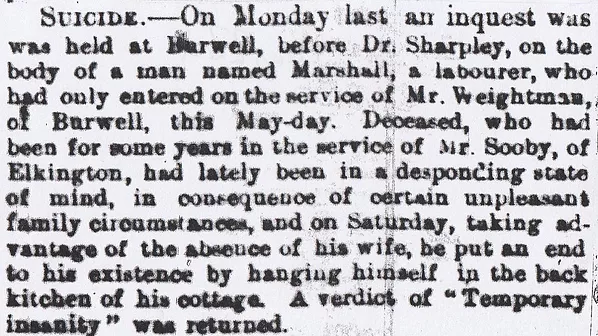
42/ Asterby Child Murder, (Louth/Horncastle) April 1895
Sarah Gibson aged sixteen was left in charge of the youngest child of the house, her brother aged only two years. Mrs Gibson had gone to the next village and her husband was expected soon, so there should have been no worries. William Gibson entered the house and found that his daughter had gone out but the little boy was laid on the floor, drenched in blood. Sarah had smashed the child over the head with a poker because she was mad at him for shoving her. A verdict of “Wilful Murder” against the girl of weak intellect.
43/ Croft near Skegness, March 1843 (Manslaughter)
A ghastly discovery was made at the little village of Croft, purely by accident. A young lad thought some of the folks of Croft might like to see a seal and tapped on doors asking them. He ended up at Mrs Evison’s cottage, who lived with her sister there when he heard a faint voice calling for help. He ran to Mr Searby, a farmer who lived next door, and they went back to check it out. The two women were bound together both hands and feet and covered with the bed sheets. Poor Mrs Evison had died and her sister was in a deplorable condition. A thieving criminal had climbed in the window attacked the women and tied them up, then robbed them, and got a bite to eat and then legged it. He is now wanted on a charge of murder. (Ever find the guy?)
44/ Ashby near Scunthorpe, October 1913 (Strange Death)
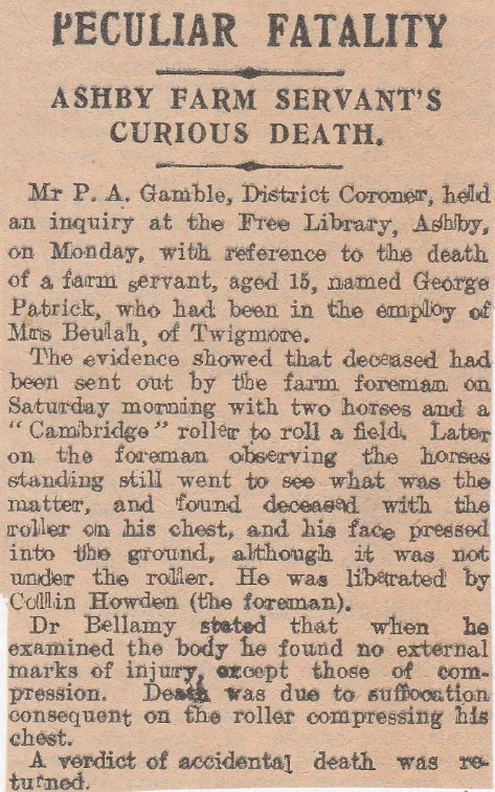
45/ Ashby (Scunthorpe), August 1920 (Child Burnt to Death)
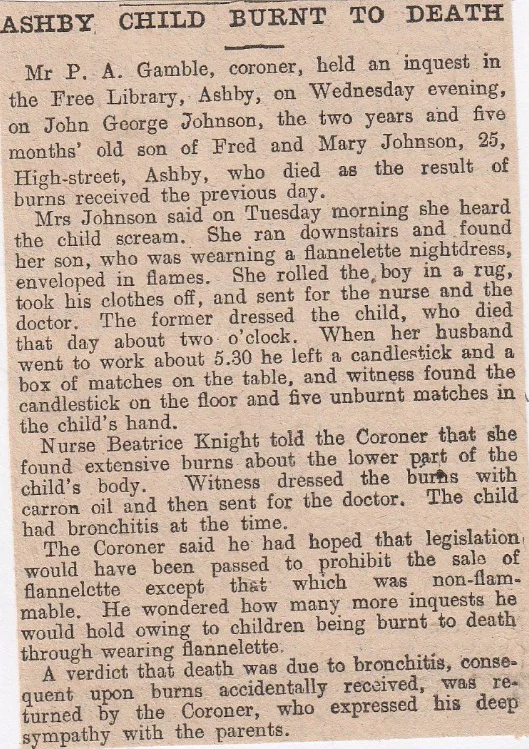
46/ Farlesthorpe (Alford), July 1884 (Fatal Accident)
Mrs Lucas of Mumby and late of Farlesthorpe fell down some steps on Wednesday and dislocated her neck. It appears the neighbours, not having seen the old lady about as usual, became alarmed and ultimately broke the door open and they found her lying dead at the bottom of some steps leading to a bedroom. It is singular that her husband, the late Saint Lucas, broke his neck in the same manner about nine years ago.
47/ Authorpe (Alford), May 1875 (Fatal Accident)
A fatal accident occurred at Authorpe to a man named James Farmery, residing at Aby. He was engaged with Mr Turner, the proprietor of the brick-yard, in taking away some centres from a newly-erected arch, when it fell upon him and killed him instantly. The body was extricated and it was found to be badly mutilated and was left exposed for some hours before removal. The verdict was “Accidentally killed”. Deceased was fifty years of age and has left a wife and a family. Mr Turner suffered from a fractured leg and is now progressing favourably.
48/ Broughton (Brigg/Scunthorpe), August 1865 (Fatal Accident)
A fatal accident occurred at Broughton to a labouring man who was working digging gravel in a pit and having incautiously undermined, a mass fell upon him and so fearfully crushed him that when extricated life was extinct. The calamity is not likely to end with the man; his wife, who was abruptly informed of the death of her partner and being far advanced in pregnancy was at once stricken down, and the case is likely to terminate fatally. The verdict was “Accidental death”. The deceased whose name is Houghton was a native of Wrawby.
49/ Belleau Rectory Fatality, May 1869
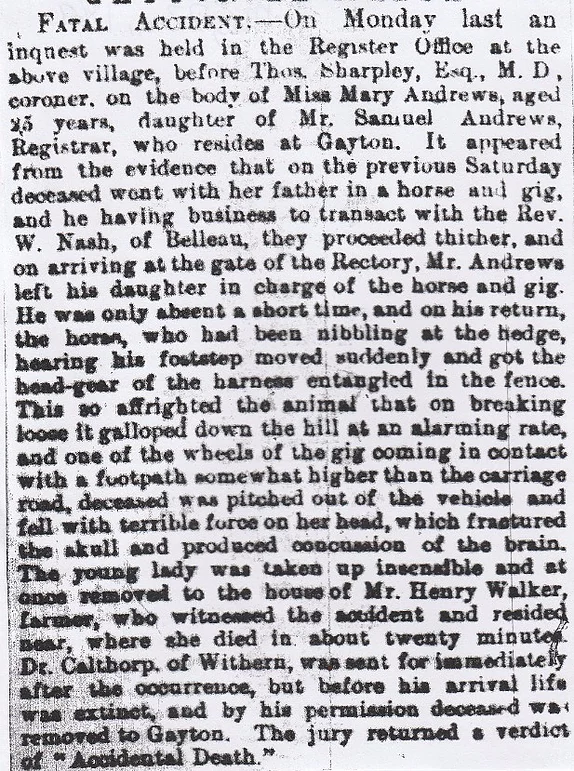
50/ Belchford Suicide, (Horncastle) October 1879
Isaac Lammiman aged fifty-four years killed himself by hanging in his granary. He had been much depressed on account of the adverse state of agriculture. James Maltby went to his house at nine a.m. to borrow a horse to move some trays from Horncastle and deceased’s wife said he wasn’t at home. He then heard a cry of “Maltby, Maltby, what shall I do?” as he was walking down the road, it was his wife at the granary window. He ran back and found Lammiman hanging by his neck. The body was cold to the touch.
51/ East Barkwith, July 1888 (Killed by Lightning)
Mrs Ann Overton, the wife of John Overton the publican, was found dead in a field near her residence. Her daughter Eliza, said her mother had just gone into the garden when a thunderstorm came overhead. She was looking at some hay-makers in the next field and had been gone a while when they found her lying on the ground underneath some trees. Eliza shook her but discovered no life in her body. The doctor arrived and found her hair singed as was the collar of her jacket, the skin on her face was black, with her cap also singed. Her slippers were in tatters. He had no doubt that Ann had been struck by lightning.
52/ Cumberworth near Alford, June 1889 (killed by a Horse)
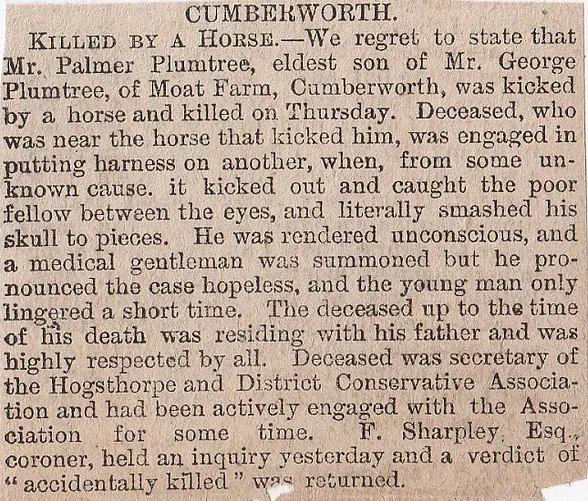
53/ Bardney Railway Death, March 1883
John Flack was knocked down by a G.N.R. passenger train and was horribly mutilated. Flack was from Suffolk and was looking for work, and was spotted by the driver of a down train from Peterborough to Doncaster walking up the line. The up train from Lincoln to Peterborough was only 200 yards to the rear. The driver shouted at the man but got no answer, and deceased was then knocked down and killed. A surgeon from Bardney stated that the top of his head and his back were completely destroyed. The brain had disappeared and the head was empty; both legs were also severed from the body. The wife of the deceased identified his clothing as that of her husband.
54/ Bardney Railway Death No.2, March 1882
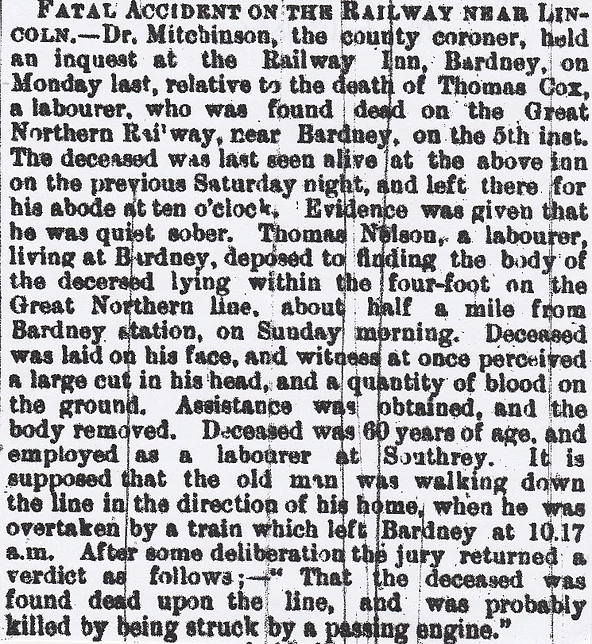
55/ Anderby (Mablethorpe/Skegness), September 1877 (Horrific Death)
An inquest was held on the body of George Wallis aged fifteen. He was assisting at a threshing machine for Miss Gibbons of Anderby, when he stepped into the drum and had his right leg drawn in and fearfully mangled. They tried to liberate the poor lad from his perilous position and when they did he was conveyed home to Mumby. The doctor arrived and bound up his leg in order to stop the bleeding. Two doctors returned later on to amputate the leg but the poor lad was sinking. This intention was abandoned as he would have died under the operation. He sank further and further until at one a.m. on Sunday morning he expired. The boy was there with his uncle learning about the business, and just as the accident occurred they were about to stop the machine with the operator having his hand on the handle to turn off the steam. He was interred at Mumby with many young people turning up and following them to the grave.
56/ Bilsby (Alford), August 1877 (Terrible Accident)
Mrs Hundleby, the mother of the nine-month-old child that died, placed it in an armchair with a scarf around its body and attached it to the back of the chair to stop it falling off. She went out for a bit and came back and fed the child, only this time going next door and leaving the bairn to be looked after by a six-year-old girl. After a few minutes, the girl went to get Mrs Hundleby and said the little one was crying. When they got back, the child had slipped through the scarf up to the neck and got through the back of the chair and not getting clear of the scarf, was thus strangled. She snatched it up and ran into the street screaming. A man named Leechman took hold of the child, but it was extinct. A verdict of “Accidental strangulation” was returned and the mother was reprimanded for her gross negligence.
57/ Bratoft Suicide, (Spilsby/Skegness), October 1880
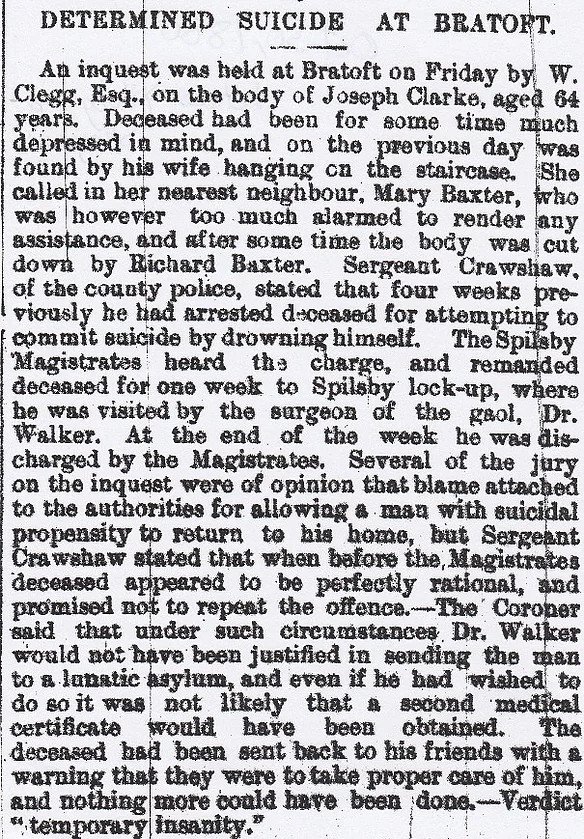
58/ Castlethorpe near Brigg, April 1906
Harry Lamming, a tinsmith, was driving the horse and gig with his wife and child as passengers when the horse shied. All were thrown down to the ground with a hefty bump but Lamming landed head first. He sustained a fractured skull and was dead within a few hours. Mrs Lamming and the child are both recovering favourably at this time.
59/ Calceby, July 1848 (Attempted Murder)
Elizabeth Garner aged thirteen was indicted for administering arsenic to her mistress, Mary Smith, with intent to murder her. Garner left home and got a job at the home of the bedridden old woman living in Calceby near Alford. The girl became home-sick, and the mother-in-law had gone to see Mrs Smith and ask her to allow her to leave, but she was told to hang on until she had got somebody else for the job. Garner found some mixture used to destroy vermin on sheep and that contained arsenic, mixed it with some milk and gave her some of it. The old lady spat it out and ordered the girl to take a swig, which she did and she too spat it out. Mrs Smith started vomiting and complained of burning in her throat. It had all the indications of poisoning according to the doctor who was called in. Smith gave the contents of the milk-jug to the doctor, to analyse. He found it contained arsenic and the girl was quizzed about it. Garner stated: “I knew it was poison; I believed it would kill the woman. I gave it her, to be set free”. The jury found her guilty and she was sentenced to death. (I have a feeling that she didn’t die on the gallows but was given a lenient sentence due to her youthful status).
60/ Eastville Poisoning, April 1860
Love the name Eastville, always thought it should be in Kansas in the late 1800’s. It is not, and lies between Skegness and Boston. It tells of a twenty-two-year-old woman from Eastville was accidentally poisoned by arsenic, which she found in a cupboard in the house. She had mistaken the jar for sulphur. (Did she die?)
61/ Eastville Station Fatality, August 1881 (Still there, but now derelict)
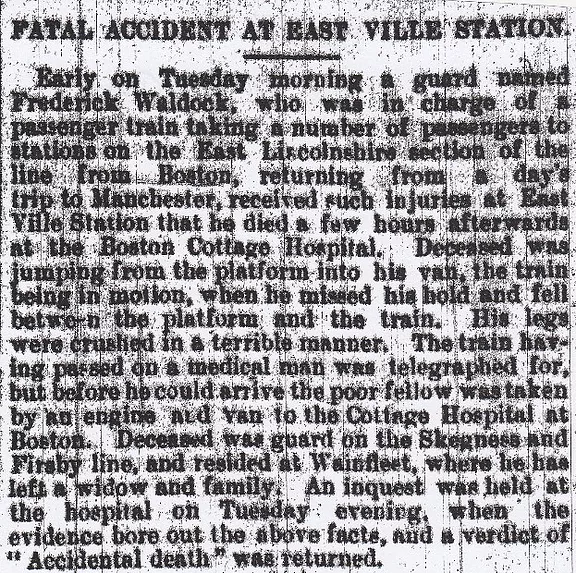
62/ Frodingham Drowning, July 1882
On Wednesday afternoon a youth named Arthur Brown was drowned whilst bathing in a pit adjoining the Trent Ironworks. Another lad was with him at the time, and seeing his companion sinking, ran to the works and gave an alarm, but before the little fellow could be got out in time and life was extinct.
63/ Frodingham Railway Death, November 1899
A collision occurred at Frodingham Viaduct when a goods train for Frodingham was creeping slowly over the viaduct when a couple of light engines crashed into its rear. The guards’ van of the goods train was smashed to smithereens with the guard being killed instantly.
64/ Frodingham, December 1892 (Arch Collapses- Four Dead)
An arch at the Frodingham Steelworks near Scunthorpe, collapsed, causing four men to lose their lives. It was a brick arch with a layer of concrete on top, used as a smithy. The men were all bust at the time and received no prior warning, they were all crushed and burned to death underneath the tons of rubble. Men were arranged into groups to help clear the debris, but the task took several hours before all the corpse could be found and brought out. The dead were: Moses Parker, a striker from Frodingham; William Hobson, striker, Frodingham; Joseph Shucksmith, crane driver, from Ashby; and John Southwick, blacksmith, from Scunthorpe.
65/ Driby near Alford, (Fatal Accident)July 1883
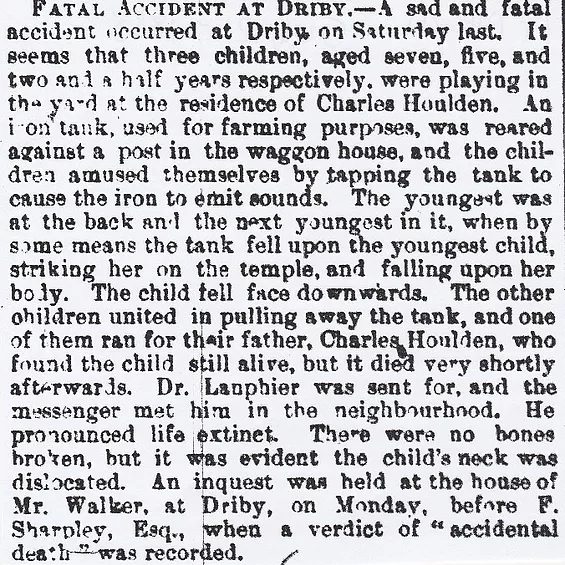
66/ Fiskerton Murder, July 1864
Richard Thomas Parker, a butcher aged twenty-nine, was charged with the wilful murder of his mother, Elizabeth Parker on May 16th at Fiskerton. There was another charge of attempted murder on his father, Thomas Parker. His mother let him go to Sheffield on an excursion trip and when he came back he seemed in a volatile mood, by answering his mother back and when his father intervened, he swore at him. Richard then went to get his gun and returned and fired off two shots, one at his Mum and one at his Dad. When he was apprehended for the shootings someone heard him say,”I have shot my mother, and I shall die like a pig on the scaffold”. An excuse for his behaviour was that he had sustained a head injury some years back when he came off a horse. That mixed with his drinking habits, the two clicked and he turned into a psychopathic killer. He got his wish and he was sentenced to death.
67/ Epworth, December 1869 (Attempted Murder)
William Daniel Webb aged forty-four, a tinman, was charged with feloniously wounding Ann Webb his wife, with intent to kill and murder her at Epworth on the 21st of October 1867. His Lordship remarked that he was morally guilty of murder and should, therefore, be sentenced to fifteen years penal servitude.
68/ Epworth Rectory Hauntings, December 1715-January 1716
The Reverend Samuel Wesley, his wife, and some of their nineteen children were the focus of some poltergeist and spectral activity in their home, Epworth Rectory. John Wesley, the most famous of Wesley dynasty for founding the Methodists was at boarding school, so never got to experience the haunting. Moaning and wailing, sounds of footsteps and banging noises kept them awake at night. One of the daughters saw a typical ghostly figure akin to being dressed in a white gown, the spectral figure got the nickname “Old Jeffrey”. No more was heard of it after January 1716 as the haunting stopped.
69/ Epworth Suicide, February 1907
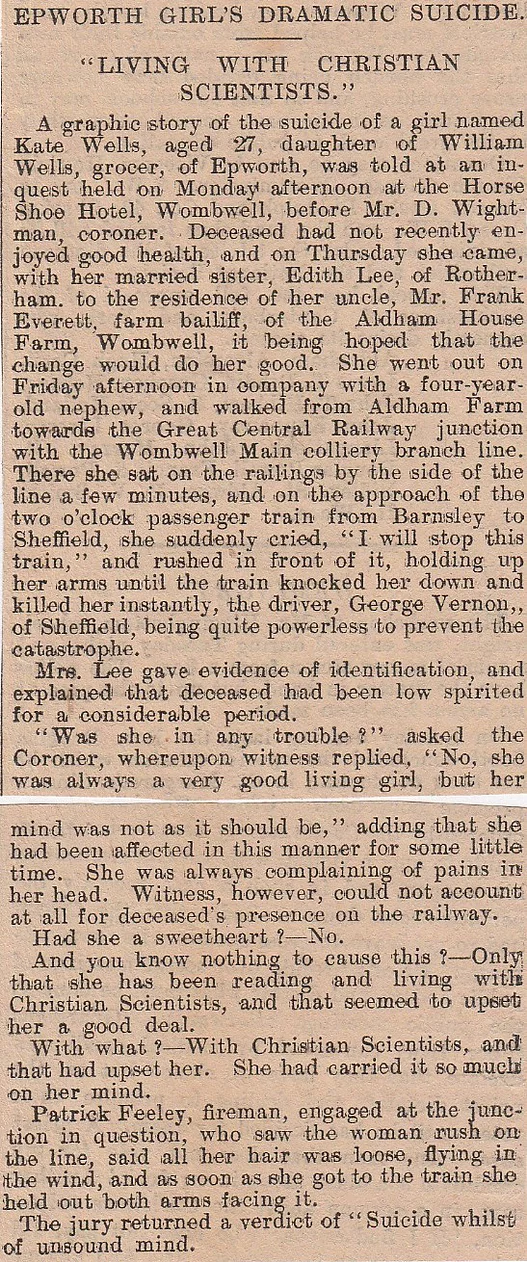
70/ Eastoft Murder, (Scunthorpe) October 1902
Charles Williams, a simple farm worker from Eastoft, was stabbed by a 40-year-old potato picker named John Walsh. Williams was on his way back from Luddington with a girlfriend when on the outskirts of Eastoft Walsh flew at him in a rage and knocked him down. They scuffled for a bit, and after a while, Williams gasped “He knifed me”, then Walsh attacked her. She wasn’t as badly injured as Williams and managed to get help. When they returned to the spot, Williams was in a ditch. Police arrested Walsh and in the meantime, Williams had expired from his stab wounds. The actual stab wound was in his thigh and had severed the femoral artery, causing the death to be from haemorrhage from the cut. He was found guilty of murder. I presume the death sentence was forthcoming?
71/ Eastoft Murder, March 1870 (Murder in January 1870)
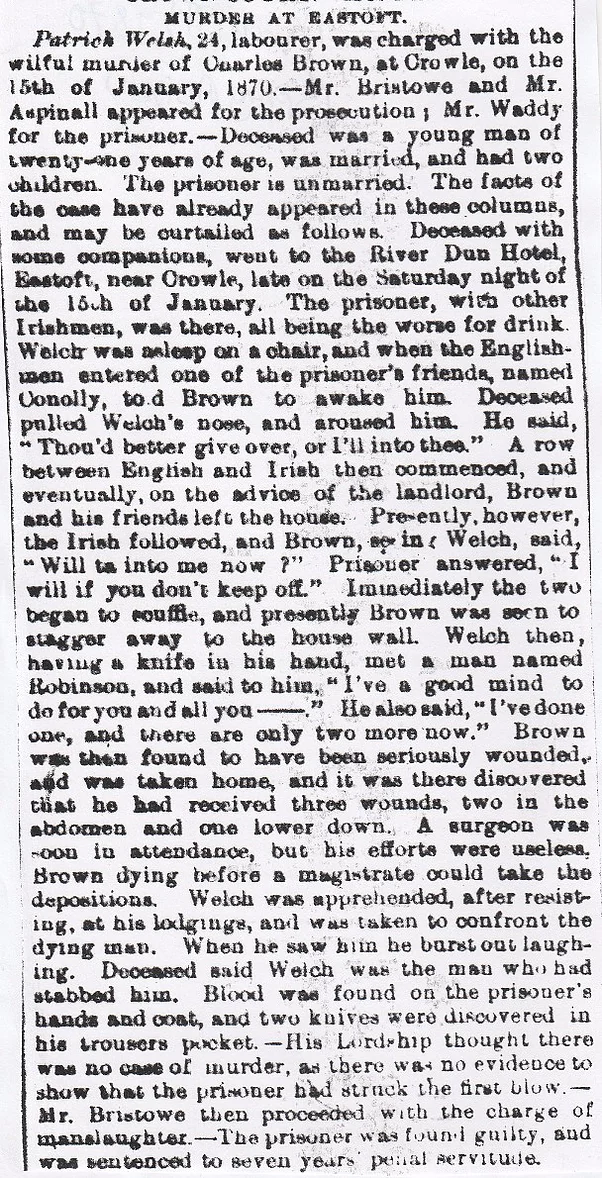
72/ Dalderby Bridge Suicide, near Horncastle, August 1888
Early one Sunday morning, the body of a respectably dressed man was discovered at Horncastle near the Dalderby Bridge. A revolver shot had penetrated his forehead and the weapon itself was lying by his side. The body was quite cold and was partly lying in the water. The deceased had upon him thirty-five shillings and a silver watch and chain. He was apparently a foreign horse dealer who was in Horncastle for the annual fair, but there being no papers in his possession there is no clue to his identity.
73/ Friskney, September 1851 (Death-bed Confession)
A boy named Enderby disappeared in 1835 or 1836, and was only about thirteen years old and was the adopted son of Mr Enderby, a Skegness publican. On the day he vanished he was up at three a.m., to get some horses and go to Louth with some corn, but was never seen or heard of again. A man named Candy Taylor, a full-time criminal in the Friskney area, confessed to the boy’s murder while he was on his death-bed. His accomplice, a man named Milnes from Croft, also mentioned something about the boy’s murder before he croaked some years ago. Apparently, the lad had witnessed them slaughtering a sheep so to prevent the lad from grassing on them to the authorities they killed him and buried his body at Ingoldmells.
74/ Brackenborough near Louth, May 1881 (Fatal Accident)
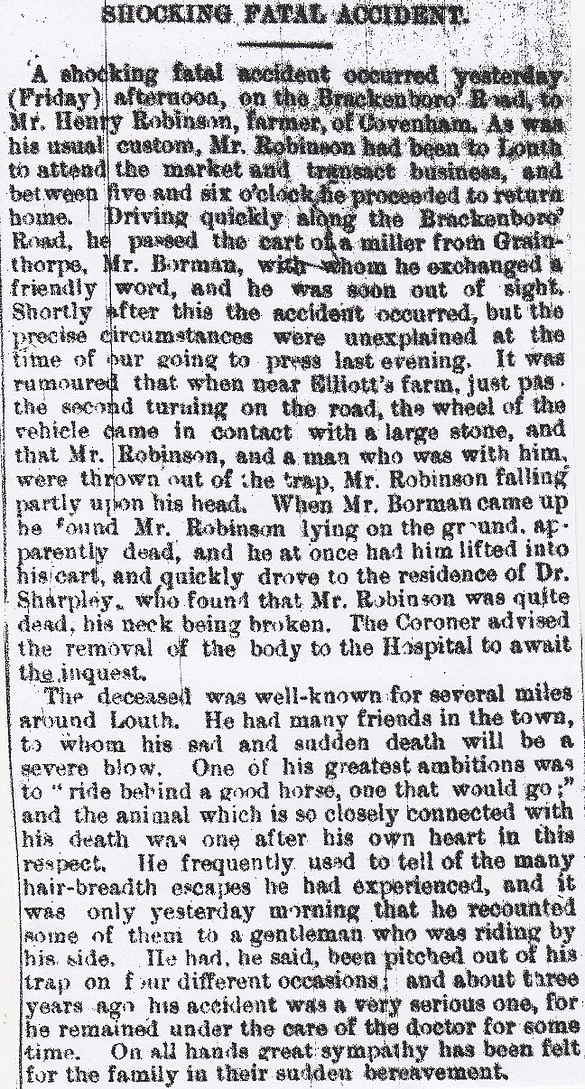
He was fifty-one and was interred in the churchyard at Covenham. The verdict on May 28th-“Mr Robinson’s death was caused by being thrown from his conveyance”.
75/ Benniworth Suicide? September 1888

76/ Crowle near Scunthorpe, January 1877 (Butcher Sells Wife)
William Liggot, a pork butcher, sold his missus to the landlord of the Fishmonger’s Arms, Chapman Pidd, for the princely sum of £40. It was all done above board with a solicitor drawing up the articles of sale then the £40 was handed over and the wife had a new husband. Pidd’s wife died a few months ago and had become lonely and jokingly asked Ligott if his missus was for sale.
77/ Crowle, February 1884
At Retford, information was received that a man well known to police, named Thomas Cunningham, was wanted for the attempted murder of P.C. Thomas Dunn at Crowle. Cunningham was out poaching and shot at the officer. He was some time ago before the Retford Bench for the attempted murder of a P.C. at Stockwith. The officer, Thomas Fryer, had arrested Cunningham and another but when in the cell they “rounded on him” and but for the assistance of a person who was passing the station who heard the commotion, the officer declared the belief that he would have been murdered.
78/ Crowle, April 1871 (Boys Death Playing at Hanging)
William Meggitt aged thirteen and a half, met his death while playing at hanging. The mother, Sarah Seaton, had gone out one day and left him working in the garden. When they returned in the evening they discovered him suspended by the neck in a pig-shed, quite lifeless. John Clark, the husband, found him on his knee’s with the rope around his neck and the other end tied around a beam in the roof about five feet from the ground. His head was tilted slightly and his hands at his side, with a proper noose used. The boy was always saying about hanging but it was thought to just have a morbid fascination for it, but it ended in tragedy and he actually hung himself while probably seeing what it was like.
79/ Crowle Drowning, August 1920
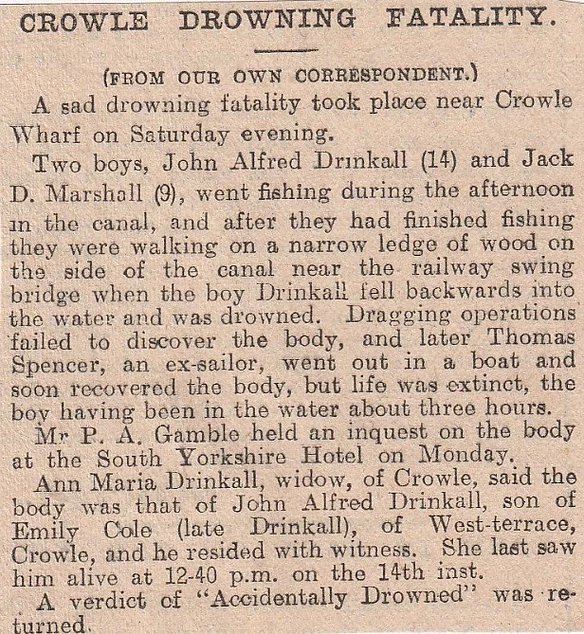
80/ East Ferry Murder, December 1882
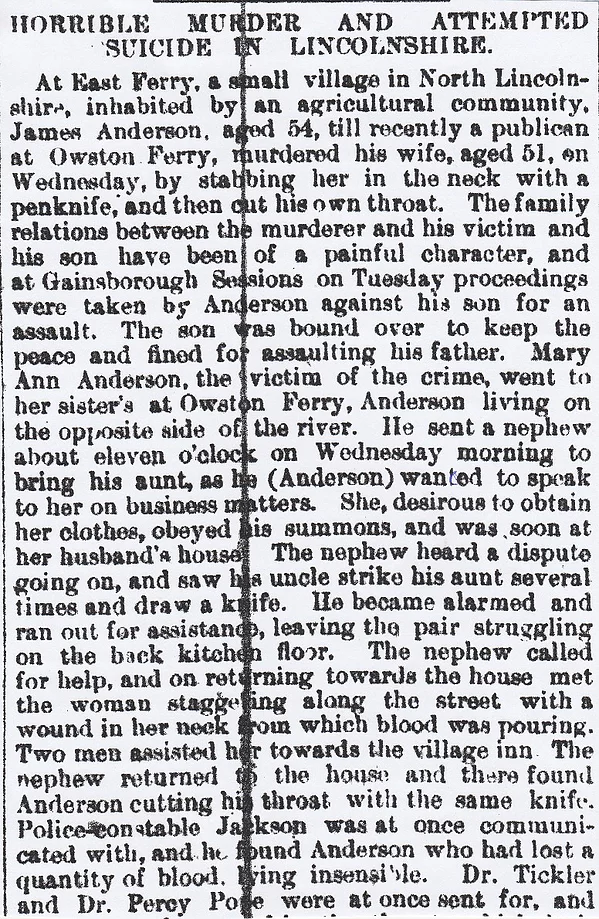
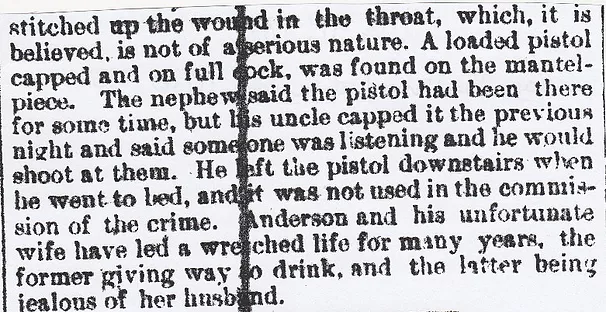
February 1883- Execution at Lincoln
Fifty-year-old James Anderson, a mariner who murdered his wife on December 6th, 1882 at East Ferry was hanged at Lincoln Gaol. When the Reverend told him that he was going to enter into eternity and asked him how he felt about it, he simply replied:-
“Well, I’m simply going home, and I don’t want to stay here. There’s nothing here I care for”. Marwood entered the cell a few minutes before nine o’clock and continued to tie the arms behind his back. After the clock struck nine he was conducted to the scaffold, and he appeared to be somewhat pale but calm and collected. The white cap was placed over his head by Marwood and the noose adjusted around his neck. The executioner stepped back to a level at the side of the drop and pulled the handle over, and the body dropped into space with a thud. The rope quivered a little but death was instantaneous. The drop was eight feet. The black flag was then hoisted on the clock tower. The body was allowed to swing for an hour then taken down and removed to the dead-house.
81/ Aby Suicide, near Alford, January
A terrible case of suicide took place at Aby, when Mr Joseph Peacock aged fifty-five, nearly severed his head from his body under circumstances detailed below. He was much respected in the village, with him being the Vice-Chairman of the Lodge of Oddfellows. He had been a lay preacher with the Wesleyan Methodists for about twenty years and a teacher at the Wesleyan Sunday School-indeed some of the symptoms indicated that religious mania was the cause of taking his life. He leaves a widow and family. He was found in the closet adjoining the house by his wife at about seven a.m. He was clearly suffering from insanity or something similar. The verdict was one of “suicide whilst not of sound mind”.
82/ Aby Railway Station Fatal Accident, March 1867
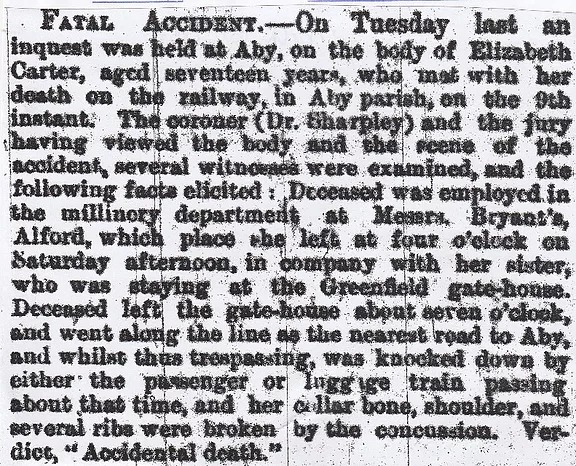
83/ Burgh-le-Marsh, (Skegness) 1629 (Mary Rose Shipwreck)
I doubt whether this is still carried on but the church bell at Burgh-le-Marsh was rung at 8 o’clock in the evening, between the months of October and March. It was some sort of tradition because in 1629, the Mary Rose (not that one!) was nearing the coast and the locals would ring the church bell to warn the ships if they came to close, a sort of sonar lighthouse. On this occasion, they decided not to and claim some of the booty that would wash up on the beach, but the vicar went to the church and locked himself in, and rang the bell to warn them off. The angry villagers broke down the church door and found him lying dead on the floor after he’d suffered a heart attack by exerting himself.
84/ Burgh-le-Marsh Suicide, July 1884
Marshall Heanley aged about seventy was discovered hanging from his bedpost by his daughter at about nine a.m. on Monday. The verdict was returned that deceased had destroyed himself by hanging whilst in an unsound state of mind. He was well respected in the area and up until a couple of months ago he lived at Croft Grange and was a farmer and a member of the Lincolnshire Chamber of Agriculture.
85/ Burgh-le-Marsh Railway Death, August 1863
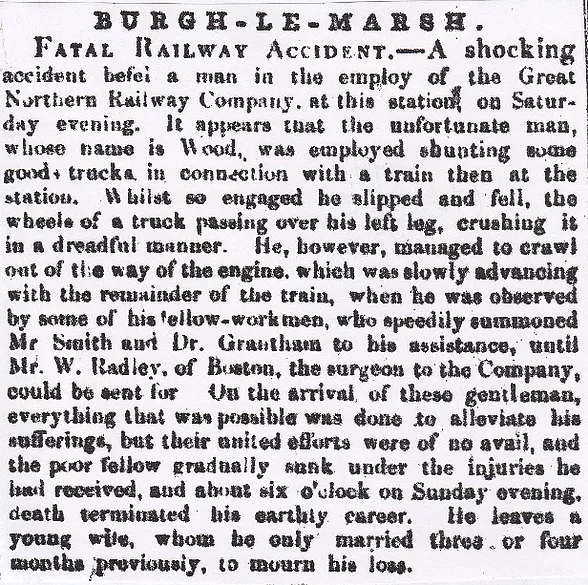
86/ Burgh-le-Marsh Railway Station Fatality, October 1885
Maud Pickett aged ten years, died in the house on the previous day having been brought from Burgh Station where she met with an accident on the line. The little girl was run over by some railway carriages at Burgh Station, where a gentleman on the train offered to take her to Louth to attend the hospital there. She died in the hospital after a couple of days there. The jury questioned whether it was wise to bring the girl twenty miles to Louth or go to Boston which was nearer. Her father, who was the railway porter at Burgh Station, said she was in the goods shed, and Harris, the shunter, was taking two waggons out when he heard her scream. Her left leg had been almost severed by the carriages running over her. It was decided that it was best to take her to Louth. It is believed she fell between the buffers. “Accidental Death” was recorded.
87/ Burgh-le-Marsh, (Skegness) October 1880 (Two killed)
A dreadful accident occurred at Burgh-le-Marsh resulting in the death of a waggoner and a little girl and seriously injuring a dozen others. The whole affair has cast quite a gloom over the neighbourhood. At six p.m. on Monday evening, a waggon drawn by three horses was returning from the harvest field with a load of beans, upon which were seated a number of children. When near the church the kids shouted “Harvest home!”, which startled a baker’s horse in a tradesman’s door. He backed against the waggoner, throwing him to the ground. The horses took fright and galloped down the street with the waggon passing over the man’s body. They ran on and turned a corner sharply, throwing the twenty or so children against a wall. Two doctors appeared on the scene to help the wounded, The case of poor Archer was hopeless and he died on Tuesday, leaving a wife and five children. Archer East aged thirty-six is dead, and Lucy Peacock aged nine is also dead. Peacock had her skull fractured and died on the same night. East lingered till the next day with his bowels and bladder ruptured.
88/ Burgh-on-Bain Drowning, (between Louth/Mkt Rasen) September 1883
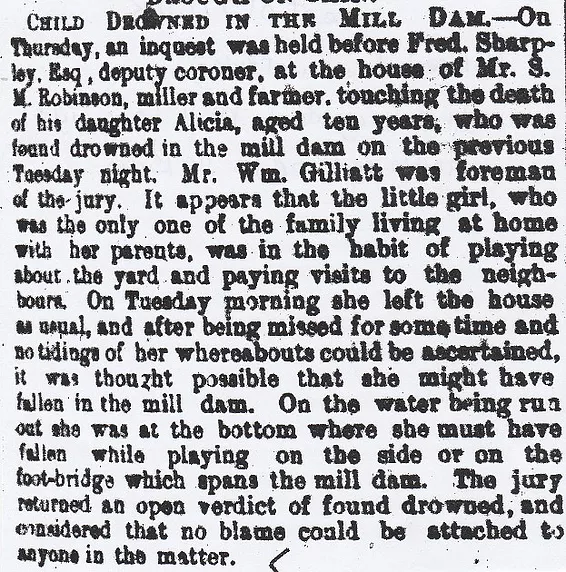
The mill was all the way down Mill Lane, right to the end, up to the River Bain (I think!)
89/ Between Claythorpe/Alford Stations, January 1881
A foreman platelayer named John Portasaged thirty-eight, met his death on the G.N.R railway whilst laying new rails between the Claythorpe and Alford Stations. He was sitting at one end of the rails in a waggon, his legs were injured by the rails hanging over the next waggon closing upon him, when the train stopped. He had no broken bones but he was taken to Louth hospital. The first few days he was doing fine but erysipelas set in and he died at eight o’clock on Sunday night.
90/ Claythorpe Railway Station Fatality, August 1884
A porter at Claythorpe, by the name of Samuel Desforges aged twenty-five, was run over and mutilated by an excursion train which was expected to pass through the station. Deceased had shut one gate and was running to shut the other when the train caught him. Nobody witnessed the accident. The clerk in charge at Claythorpe said that Desforges had to attend to a man with corn near the end of the goods shed. It was also his duty to attend the gate while he and others were on a break; also to set the signals and close the gates. At 7-50 a.m. an excursion train passed through the station and he was run over and killed.
91/ Claythorpe Railway Fatality, May 1865 (Near South Thoresby/Alford)
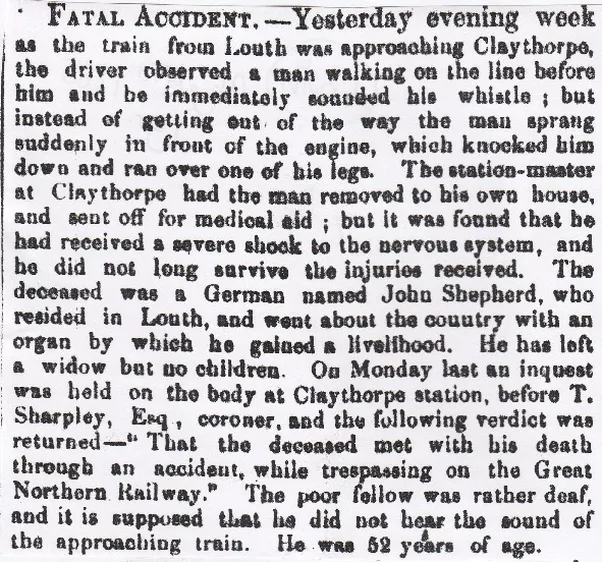
92/ Firsby Clough/Thorpe, (Spilsby/Skegness) April 1849
John Ward, who lived in Thorpe near Spilsby, committed matricide by shooting his mother in the head and killing her instantaneously. John had taken a fancy to a domestic servant at the house and his mother had told him off and told him not to fraternize with her anymore. He ran out shouting that if they couldn’t be together, he’d shoot her. After several hours he returned. He crept into the house and saw his Mum asleep in a chair by the fire. He got a gun and blew her head away, at point-blank range. Then he grabbed the love of his life and locked her in his room. She craftily escaped by saying that if they were to run away together she needed her clothes and he let out, and she ran next door for help. He went after her but was stopped from doing so by the owner of the house. Feeling a bit of a failure he tried to slit his own throat but he couldn’t even do that right. A doctor found him and sewed his wound up. (On the bank of the Lymn, a side drain connecting with the river about a mile from Thorpe village, is a farm known by the name of “Firsby Clough”.)
93/ Firsby Death, January 1916.


94/ Firsby Suicide, May 1880
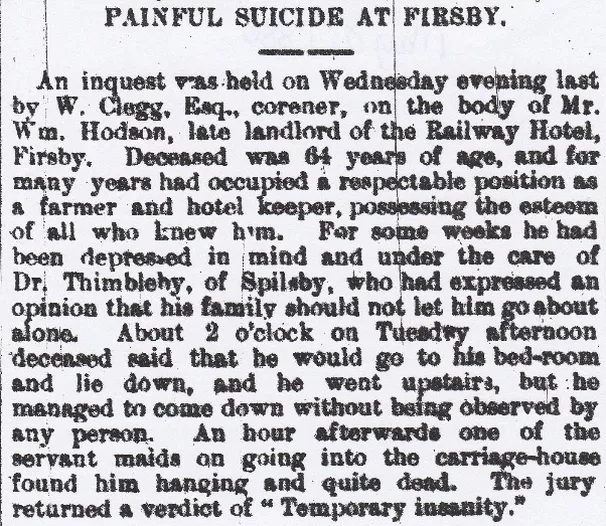
95/ Donington-on-Bain Suicide, June 1869
William Fletcher, sixty years old and a shoemaker by trade and from Donington-on-Bain, killed himself by taking laudanum. Not known as a hard drinker he had in the past few years gone off on two or three-day binges in the surrounding public houses. He had been on one of these binges and put an end to his deplorable career by taking four ounces of laudanum. Whether this was to help cure his previous debauchery or to commit suicide, we will never know. The verdict suggested suicide, but what state of mind he was in, there was no evidence. Nobody had a bad word to say about the old fella saying he was kind, punctual, and always civil to everyone who met him.
96/ Donington-on-Bain Child Murder, May 1873
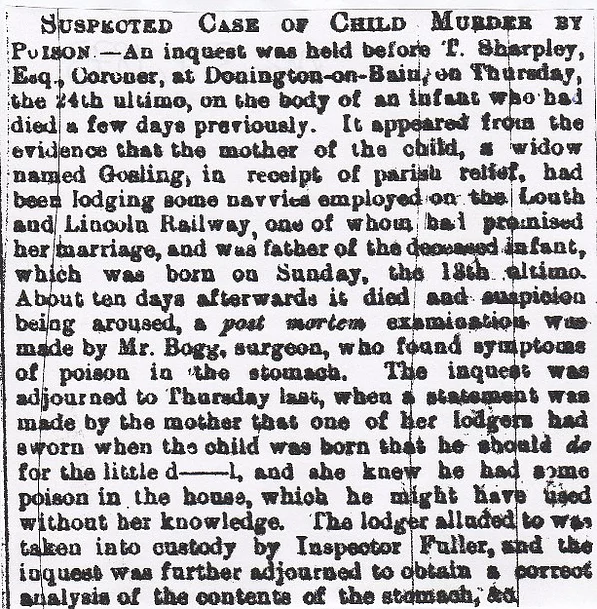
97/ Donington-on-Bain Railway Deaths, February 1877 (Two Killed)
Adam Chambers, a foreman plate-layer on the Louth and Lincoln Railway, was killed when he was run over by a moving trolley on the line. They were moving two trolleys with some material on them between Willingham and Withcall stations, Chambers was on one of them, with three others. When they got near Donington-on-Bain, on one of the trolleys, the men saw a red light which means danger, so they got off the two-ton trolley as quickly as possible and none were injured except Chambers, who was run over by the trolley behind them. He lost two or three pints of blood before he got to Louth Hospital, and his leg had two large lacerations in it. He lingered for a day but finally expired from his injuries. Another man was killed at Donington-on-Bain Railway Station. Frederick Flintham aged twenty-five, was on his way back from Louth Market and was on the 6-35 p.m. train to Donnington. About 150 got out at Donington, and as the train was moving off he was yelling out “good night”, and he slipped and fell under the wheels of the penultimate carriage. He was pulled up from the tracks and was to be rushed off to Louth Hospital, but died within half an hour. He has left a widow in a destitute condition.
98/ Donington-on-Bain Death, January 1869
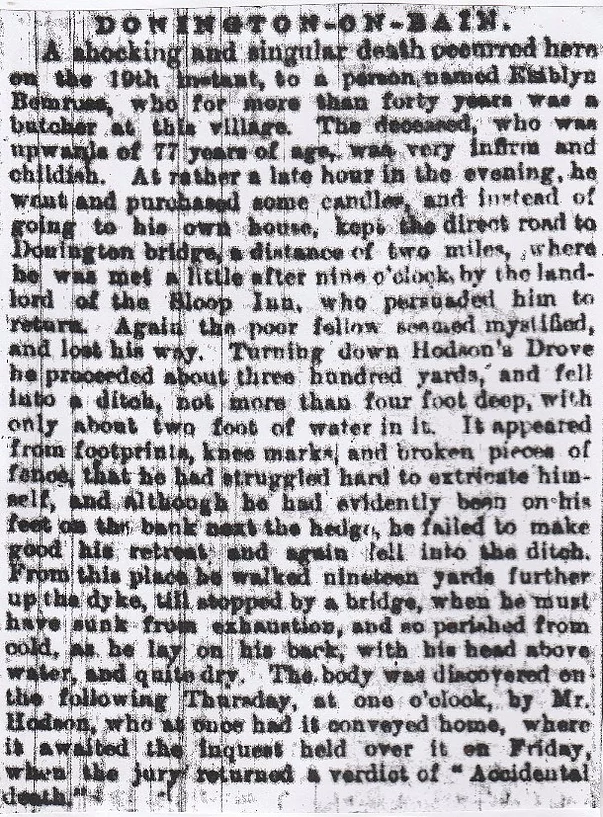
99/ Farlesthorpe Suicide, (Alford) April 1881
John Dales, who lived on a small farm near the highway at Farlesthorpe, committed suicide in a most determined manner. He was a thirty-eight-year-old, well built, sober, and diligent sort of bloke, with a wife and four kids to provide for. He had been to Alford that day to buy seed and called on Mr Chapman saying that he would see him tomorrow about some business concerning his farmland. He had tea at eight p.m., then fed the horses at 8-30, but did not return. The mother-in-law, Mrs Bilton, with whom they lived, called him in but got no answer. The horses were “winnying” so she got a lantern and went to see where he was. The wind blew her light out so she checked the straw shed, less than six foot high, and touched a body in the dark. Thinking he was messing about she threw her arms around him, only to find him hanging dead. She screamed “Oh Jim! What have you done”, and ran to get her husband. He cut him down but he was completely limp and lifeless. About two weeks ago he was converted by a preacher, Lot Ward of Alford, when he was told to cry out for mercy and pardon his sins. The verdict was “Suicide whilst of unsound mind”. (Farlesthorpe had a population of 97 in 1881).
100/ Brocklesby Hall Fatality, August 1881
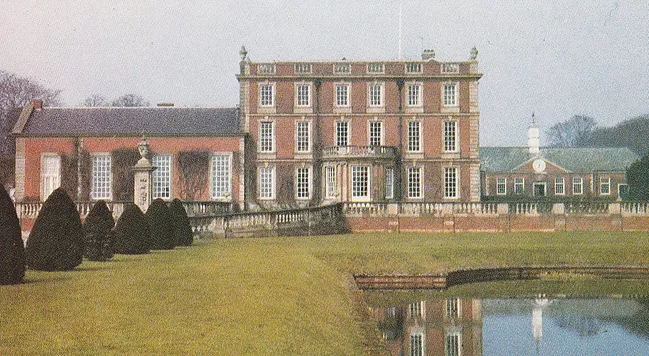
An inquest was held at Brocklesby Hall on the body of John Henry Brooks aged twenty-three years, a member of the First Lincolnshire Light Horse Corps. Deceased, who is the son of Mr Brooks, an eminent agriculturist of Wootton Grange, was on parade on Wednesday morning, July 27th, just as troop was forming line previous to breaking off from the first morning parade, Mr Brooks’ horse reared up and backed about. Its rider tried to get it into proper position but again pranced about and reared up and fell with its rider, who fell clear of the horse then alighted on his head and shoulders and when picked up was unconscious. He was removed to one of the bedrooms in Brocklesby Hall. Deceased died from concussion of the brain. Verdict- “Accidental Death”.

